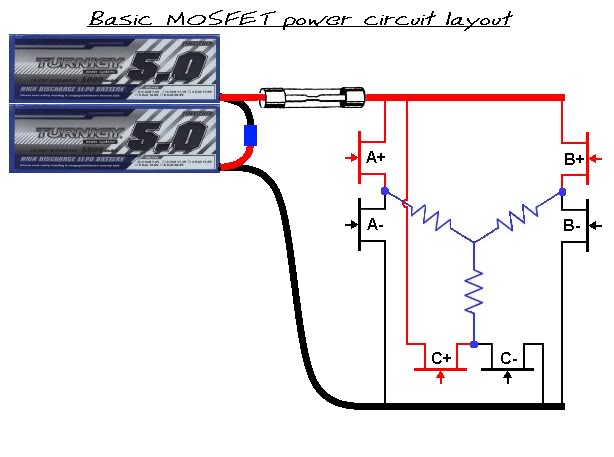Hi Anthony,
Here's my interpretation, I think
PWM is used to control the current and the three Hall sensors embedded in the stator simply control the switching of the individual phases relative to the position of the magnets on the rotor.
Although it may be possible to electronically alter the motor timing to some extent, the actual speed at which the switching occurs will always be directly linked to the rpm of the motor shaft/rotor, because if it was switched any faster
(or any slower) the motor timing would instantly be lost.
The maximum unloaded speed of the motor will ultimately be governed by the battery voltage, and the rpm/volts ratio will be determined by the number of turns and the thickness of copper wire used for the stator coil windings.
At speeds below the motor's maximum rpm, the torque and/or speed can be controlled by adjusting the average current
(and presumably the average voltage too) by using PWM control.
Here is my representation of a very simple MOSFET power circuit that could be used to control the DC phase switching if the MOSFETS were directly controlled by three Hall sensors.
Please Note: The Hall sensors and additional circuitry is not shown, this was done to keep the power circuit diagram as simple as possible:

If the Hall sensors switched the MOSFETS either 100% High or 100% low with no PWM control whatsoever, they would effectively function as an electronic commutator, and the motor would simply run at maximum power/speed from the fixed voltage battery.
However, if the fixed voltage battery was replaced by a variable voltage power supply, the power/speed of the motor could then be controlled by varying the supply voltage just like you can with a conventional brushed motor.
From my point of view, a DC brushless motor basically works in a similar fashion to a simple DC brushed motor except that it uses sensors and electronic components to switch the polarity of the windings instead of a mechanical commutator, and I'm pretty sure that the unloaded speed of both motors will still be directly proportional to the voltage being supplied.
Having said all of the above, my understanding of how a BLDC motors and controllers work is still quite basic

so please feel free to correct me if I've got it all completely wrong.
 Alan
Alan